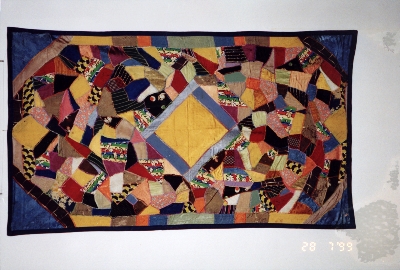Quilt No.291PC - Patricia Cmielewski

1555 x 910mm
Made by Mrs Mary Ann Sly of Rendelsham, near Millicent (SA), probably in the 1930s. It was given to Mrs Cecilia Polkinghorne in the late 1930s. Now owned by Cecilia's daughter Mrs Patricia Cmielewski.
"� For some years it was used on a grand-daughter's bed. I would think it would probably be called a Depression quilt as this was the period in which it was made and the materials are very varied. �
It was in generally good condition but had some damage to three silk fabrics which were replaced by new fabrics in October 1988 by a professional textile conservator � The quilt was lined with calico at this time also and the outer edges were bound. Velcro has been stitched to the lining so it can be hung up. ����..
Unfortunately there is not much recorded about Mrs Sly. She was Mary Ann Sly, wife of Henry Richard Sly and died at Millicent South Australia on 29/7/1959 aged 85 years. Her place of birth is unknown. Her husband, Henry, was employed by the South Australian Railways in the Far North of the State, and they came to Rendelsham in the South East of South Australia when he was transferred there by the Railways in 1914. Mr & Mrs Sly had three sons - Harold, who farmed in the Rendelsham district, Roy, who served in the RAAF in World War II, and Ernest, who was a painter.
Roy was a friend of our family and during his time in the RAAF in World War II he invented a potato-digger which the Army Inventions Directorate was developing to help the war effort. The war finished before it was in production and plans for its development were dropped."
[Patricia Cmielewski September 1999]
Related Quilts:
1820 x 1680mm
1630 x 1350mm
1525 x 1220mm
1829 x 1829mm
1910 x 1480mm
2170 x 1880mm






